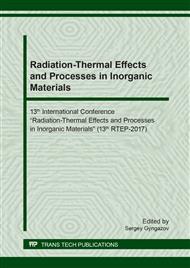p.159
p.165
p.170
p.176
p.185
p.190
p.195
p.200
p.206
Increasing the Efficiency of the Operation of the Facilities for the Thermal Processing of Raw Materials by Exposure to Electromagnetic Radiation
Abstract:
The aim of the study is to increase the efficiency of the operation of the facilities for the thermal processing of raw materials by exposure to electromagnetic radiation and the improvement of their main working organs that ensure the improvement of the quality of the product with the least operating costs. The work differs from existing studies by methodical generalization of the electrodynamic system with various design execution of the working chamber, ensuring the flow of the technological process of heat treatment and disinfection of raw materials due to repeated exposure to EMP. Because of the design features of the bulk resonators, the units have specificity in the principles of operation, in the methods of designing the nodes and all the elements of the energy transfer from the emitter to the raw material as a whole. In a constructive respect, the electrodynamic systems of microwave generators differ from existing ones by combining mobile resonator and beam chambers located in a toroidal shielding body. In microwave technology, this method of energy transfer constitutes an independent field of study. In this case, it is possible to detect the dynamics of the process taking into account the time variation in the dielectric and thermal physical parameters of the raw material, calculate the configuration and dimensions of the cavity resonator in accordance with the wavelength and the critical electric field strength, determine the number of sources and their location in the working chamber.
Info:
Periodical:
Pages:
185-189
Citation:
Online since:
September 2018
Authors:
Keywords:
Price:
Сopyright:
© 2018 Trans Tech Publications Ltd. All Rights Reserved
Share:
Citation:


